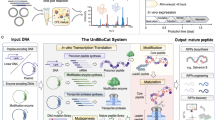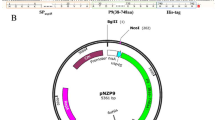Abstract
Phospholipase A1 (PLA1) is a member of the hydrolase family with applications in various fields, especially in the food industry. A calcium-independent PLA1 from Streptomyces albidoflavus was expressed in E. coli BL21 (DE3) in this study. The results indicated that the soluble expression of PLA1 was at low level, which was possibly due to the toxicity of PLA1 to the host. In contrast, the expression of the enzyme as inclusion bodies exhibited a high-level expression and 0.3 mg inclusion bodies protein could be derived from 1 mL culture medium. Furthermore, the renaturation of PLA1 was achieved through a direct dilution method, yielding 29.6 U/mL PLA1 activity after 16 h of renaturation at 4 °C. For improving the efficiency of the dilution refolding process, a continuous refolding strategy was established, and 155 U/mL PLA1 activity was derived from the continuous refolding process. With soybean lecithin as the substrate, the specific activity of purified renatured PLA1 was 1380 U/mg and the optimal temperature and pH was found to be 60 °C and 6.5. In addition, the renatured PLA1 was observed with better activity towards phosphatidyl inositol, whilst lipase activity was detected when the catalyzing temperature was below 55 °C. Overall, this study provides a possible solution to obtain calcium-independent PLA1 with high yield by heterologous expression in E. coli and hence to promote its further application in the field of food industry.








Similar content being viewed by others
Abbreviations
- PLA1 :
-
Phospholipase A1
- saPLA1 :
-
Phospholipase A1 from Streptomyces albidoflavus
- FFA:
-
Free fatty acid
- DLPC:
-
1,2-Dilauryl-sn-glycero-3-phosphocholine
- DMPC:
-
1,2-Ditetradecanoyl-sn-glycero-3-phosphocholine
- DPPC:
-
1,2-Dipalmitoyl-sn-glycero-3-phosphocholine
- DSPC:
-
1,2-Distearoyl-sn-glycero-3-phosphocholine
- DPPA:
-
1,2-Dipalmitoyl-sn-glycero-3-phosphate
- DPPS:
-
1,2-Dipalmitoyl-sn-glycero-3-phospho-L-serine
- DPPE:
-
1,2-Dipalmitoyl-sn-glycero-3-phosphoethanolamine
- DPPG:
-
1,2-Dipalmitoyl-sn-glycero-3-phospho-(1'-rac-glycerol)
- PI:
-
L-α-phosphatidylinositol
- POPC:
-
1-Palmitoyl-2-oleoyl-sn-glycero-3-phosphocholine
- GSSG:
-
Oxidized glutathione
- GSH:
-
Reduced glutathione
- IPTG:
-
Isopropyl β-D-thiogalactopyranoside
- PelB:
-
Pectate lyase B
- SDS-PAGE:
-
Sodium dodecyl sulfate–polyacrylamide gel electrophoresis
References
Ramrakhiani L, Chand S. Recent progress on phospholipases: different sources, assay methods, industrial potential and pathogenicity. Appl Biochem Biotechnol. 2011;164(7):991–1022. https://doi.org/10.1007/s12010-011-9190-6.
Chávez-Garay D, Gutiérrez-Méndez N, Sanchez-Ramirez BE, Salmeron I, Martínez-Monteagudo S. Modification of lecithin-based emulsions with phospholipases. CyTA-J Food. 2020;18(1):688–97. https://doi.org/10.1080/19476337.2020.1839566.
Lilbæk HM, Broe ML, Høier E, Fatum TM, Ipsen R, Sørensen NK. Improving the yield of Mozzarella cheese by phospholipase treatment of milk. J Dairy Sci. 2006;89(11):4114–25. https://doi.org/10.3168/jds.S0022-0302(06)72457-2.
Borrelli GM, Trono D. Recombinant lipases and phospholipases and their use as biocatalysts for industrial applications. Int J Mol Sci. 2015;16(9):20774–840. https://doi.org/10.3390/ijms160920774.
Clausen K. Enzymatic oil-degumming by a novel microbial phospholipase. Eur J Lipid Sci Technol. 2001;103(6):333–40. https://doi.org/10.1002/1438-9312(200106)103:6%3c333::AID-EJLT333%3e3.0.CO;2-F.
Sampaio KA, Zyaykina N, Wozniak B, Tsukamoto J, Greyt WD, Stevens CV. Enzymatic degumming: degumming efficiency versus yield increase. Eur J Lipid Sci Technol. 2015;117(1):81–6. https://doi.org/10.1002/ejlt.201400218.
Dijkstra A. Enzymatic degumming. Eur J Lipid Sci Technol. 2010;112(11):1178–89. https://doi.org/10.1002/ejlt.201000320.
Richmond GS, Smith TK. Phospholipases A1. Int J Mol Sci. 2011;12(1):588–612. https://doi.org/10.3390/ijms12010588.
Givskov M, Olsen L, Molin S. Cloning and expression in Escherichia coli of the gene for extracellular phospholipase A1 from Serratia liquefaciens. J Bacteriol. 1988;170(12):5855–62. https://doi.org/10.1128/jb.170.12.5855-5862.1988.
Song JK, Kim MK, Rhee JS. Cloning and expression of the gene encoding phospholipase A1 from Serratia sp. MK1 in Escherichia coli. J Biotechnol. 1999;72(1):103–14. https://doi.org/10.1016/S0168-1656(99)00096-6.
Shimuta K, Ohnishi M, Iyoda S, Gotoh N, Koizumi N, Watanabe H. The hemolytic and cytolytic activities of Serratia marcescens phospholipase A (PhlA) depend on lysophospholipid production by PhlA. BMC Microbiol. 2009;9(1):261. https://doi.org/10.1186/1471-2180-9-261.
Park J, Eom GT, Oh JY, Park JH, Kim SC, Song JK, Ahn JH. High-level production of bacteriotoxic phospholipase A1 in bacterial host Pseudomonas fluorescens Via ABC transporter-mediated secretion and inducible expression. Microorganisms. 2020;8(2):239. https://doi.org/10.3390/microorganisms8020239.
Kim MK, Rhee JS. Purification and biochemical properties of extracellular phospholipase A1 from Serratia sp MK1. Journal of Microbiology and Biotechnology. 1996;6(6):407–413. https://www.koreascience.or.kr/article/JAKO199611922236445.page. Accessed 25 October 2021.
Fu J, Huang H, Meng K, Yuan T, Yao B, Shi Y, Ouyang P. A novel cold-adapted phospholipase A1 from Serratia sp. xjF1: gene cloning, expression and characterization. Enzyme Microb Technol. 2008;42(2):187–94. https://doi.org/10.1016/j.enzmictec.2007.09.004.
Yang P, Wu Y, Jiang S, Zheng Z, Hou Z, Mu D, et al. Effective expression of the Serratia marcescens phospholipase A1 gene in Escherichia coli BL21(DE3), enzyme characterization, and crude rapeseed oil degumming via a free enzyme approach. Front Bioeng Biotechnol. 2019;7:272. https://doi.org/10.3389/fbioe.2019.00272.
Dijkstra AJ, Van Opstal M. The total degumming process. J Am Oil Chem Soc. 1989;66(7):1002–9. https://doi.org/10.1007/BF02682627.
Sugimori D, Kano K, Matsumoto Y. Purification, characterization, molecular cloning and extracellular production of a phospholipase A1 from Streptomyces albidoflavus NA297. FEBS Open Bio. 2012;2:318–27. https://doi.org/10.1016/j.fob.2012.09.006.
Laemmli UK. Cleavage of structural proteins during the assembly of the head of bacteriophage T4. Nature. 1970;227:680–5. https://doi.org/10.1038/227680a0.
Bradford MM. A rapid and sensitive method for the quantitation of microgram quantities of protein utilizing the principle of protein-dye binding. Anal Biochem. 1976;72(1):248–54. https://doi.org/10.1016/0003-2697(76)90527-3.
Blight MA, Chervaux C, Holland IB. Protein secretion pathways in Escherichia coli. Curr Opin Biotechnol. 1994;5(5):468–74. https://doi.org/10.1016/0958-1669(94)90059-0.
Murayama K, Kano K, Matsumoto Y, Sugimori D. Crystal structure of phospholipase A1 from Streptomyces albidoflavus NA297. J Struct Biol. 2013;182(2):192–6. https://doi.org/10.1016/j.jsb.2013.02.003.
Rietsch A, Belin D, Martin N, Beckwith J. An in vivo pathway for disulfide bond isomerization in Escherichia coli. Proc Natl Acad Sci USA. 1996;93(23):13048–53. https://doi.org/10.1073/pnas.93.23.13048.
Takemori D, Yoshino K, Eba C, Nakano H, Iwasaki Y. Extracellular production of phospholipase A2 from Streptomyces violaceoruber by recombinant Escherichia coli. Protein Expr Purif. 2012;81(2):145–50. https://doi.org/10.1016/j.pep.2011.10.002.
Baneyx F, Mujacic M. Recombinant protein folding and misfolding in Escherichia coli. Nat Biotechnol. 2004;22(11):1399–408. https://doi.org/10.1038/nbt1029.
Yamaguchi H, Miyazaki M. Refolding techniques for recovering biologically active recombinant proteins from inclusion bodies. Biomolecules. 2014;4(1):235–51. https://doi.org/10.3390/biom4010235.
Katoh S, Katoh Y. Continuous refolding of lysozyme with fed-batch addition of denatured protein solution. Process Biochem. 2000;35(10):1119–24. https://doi.org/10.1016/S0032-9592(00)00145-X.
Shiba Y, Ono C, Fukui F, Watanabe I, Serizawa N, et al. High-level secretory production of phospholipase A1 by Saccharomyces cerevisiae and Aspergillus oryzae. Biosci Biotech Bioch. 2001;65(1):94–101. https://doi.org/10.1271/bbb.65.94.
Yang P, Jiang S, Wu Y, Hou Z, et al. Recombinant expression of Serratia marcescens outer membrane phospholipase A (A1) in Pichia pastoris and immobilization with graphene oxide-based Fe3O4 nanoparticles for rapeseed oil degumming. Front Microbiol. 2019;10:334. https://doi.org/10.3389/fmicb.2019.00334.
Wang Y, Zhao M, Song K, Wang L, et al. Partial hydrolysis of soybean oil by phospholipase A1 (Lecitase Ultra). Food Chem. 2010;121(4):1066–72. https://doi.org/10.1016/j.foodchem.2010.01.051.
Song JK, Rhee JS. Simultaneous enhancement of thermostability and catalytic activity of phospholipase A1 by evolutionary molecular engineering. Appl Environ Microbiol. 2000;66(3):890–4. https://doi.org/10.1128/AEM.66.3.890-894.2000.
Funding
This work was supported by the National Key Research & Developmental Program of China (2021YFC2100303, 2018YFA0900300).
Author information
Authors and Affiliations
Contributions
SC, ZG, YX, and LZ conceived and designed the research. SC, CL, and PG conducted the experiments. SC, ZG, and YS analyzed the data and wrote the manuscript. ZG, YX, and LZ reviewed the manuscript. All authors have read and agreed to the published version of the manuscript.
Corresponding author
Ethics declarations
Conflict of interest
On behalf of all the authors, the corresponding author states that there is no conflict of interest.
Rights and permissions
About this article
Cite this article
Cheng, S., Guo, Z., Liang, C. et al. Heterologous expression, refolding, and characterization of a calcium-independent phospholipase A1 from Streptomyces albidoflavus. Syst Microbiol and Biomanuf 2, 487–497 (2022). https://doi.org/10.1007/s43393-021-00070-8
Received:
Revised:
Accepted:
Published:
Issue Date:
DOI: https://doi.org/10.1007/s43393-021-00070-8




